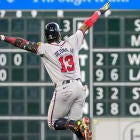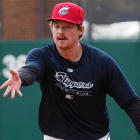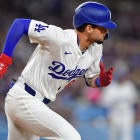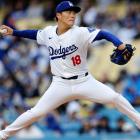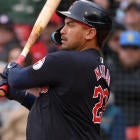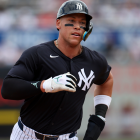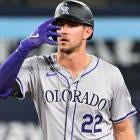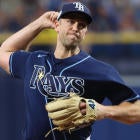Busts, 2.0 | Sleepers,
2.0
Have you seen my revised list of sleepers yet? Yeah, plenty of turnover there.
On this list, not so much, but then, that's kind of what you'd expect for a breakouts list. Generally speaking, they have more going for them than the sleepers.
Of course, they technically are sleepers in that they project to outperform their draft position, but they're more than just that. You know how a square is also a rectangle, but a rectangle isn't necessarily a square? Same sort of deal here.
To "break out," a player of some note has to do something he hasn't done already, so injury bounce-backs and unheralded rookies -- players with more substantial risk, basically -- aren't as prevalent here. But ultimately, the goal is the same as with the sleepers: to uncover value on Draft Day.
Since I first revealed my breakouts in late February, a couple more have caught my eye. I've labeled them The Newcomers and positioned them at the top. To make room for them, I had to eliminate two who are usually drafted higher than I can justify taking them. I've labeled them The Dropouts and positioned them at the bottom.
I still like them, I should point out, but for where they come off the board, I don't consider them a priority. And ultimately, this list should reflect what I'm actually doing in drafts.
Note: The numbers in parentheses reflect average draft position on CBSSports.com, assuming a 12-team league.
The Newcomers
Brad Miller, SS, Mariners (Roto: Rd. 17, H2H: Rd. 18)
After declaring myself the president of the Brad Miller fan club when he came up midway through last year, I've been lukewarm on him most of this spring.
Until I saw him play again.
I'm no scout. I'll normally trust the stats over what I see with the naked eye. But something about the way he swings the bat, man, makes me feel tingly all over.
He's just so in control at the plate, adjusting the length, speed and reach of his swing to direct the ball wherever it's most likely to fall in for a hit. And I don't mean to say he's a swing-at-anything type. He has a plan up there, and he executes it as well as any second-year player I've ever seen. He has patience, but he'll reach for a pitch if he's confident he can poke it the other way. He has power, but he doesn't sell out for the home run.
With that approach, I don't see how he doesn't evolve into a consistent .300 hitter. His minor-league track record (.334 over three seasons) and sizzling spring performance (.447 in 38 at-bats) certainly back it up. Project his numbers in 306 at-bats last year -- specifically, the eight homers, six triples and five steals -- over a full season, and he has the makings of a Head-to-Head points league stud at a position in dire need of them.
My guess is his pseudo competition with Nick Franklin, who most evaluators don't believe has the range to stick at shortstop, keeps Miller affordable on Draft Day. Given his spring performance, that may not last much longer.
Mike Moustakas, 3B, Royals (Roto: Rd. 20, H2H: Rd. 18)
Make no mistake: Moustakas was nothing short of dreadful last season, following up an encouraging sophomore campaign with numbers that made him useless in virtually all formats.
The Royals disaster of a hitting coach -- the home-runs-are-the-enemy-minded Jack Maloof, who they fired on May 30 -- may have set him on the wrong course, but unlike Eric Hosmer and Salvador Perez, Moustakas never recovered.
So he did the best thing a player whose swing has gone awry can do: He spent the offseason with his hitting coach, the much more orthodox Pedro Grifol, playing for the team he managed in the Venezuelan winter league.
Playing winter league ball is rare for a player as established as Moustakas, but even more telling than the effort he made was the work he put in. Hoping to get him back to his high-average ways, trusting that the power would come naturally, Grifol drilled Moustakas on hitting the ball the other way, having him take as many as 300 swings a day. He showed progress with a .288 batting average, three home runs and an .875 OPS in 17 games there and has continued the momentum with a .450 batting average, four home runs and 1.396 OPS in 17 games this spring.
The spring numbers are one thing -- he dominated in the Cactus League last year as well -- but the buzz is different on him this time around. And with that backstory, you can understand why.
Here's a 25-year-old who was a former second overall pick in the amateur draft and top-10 prospect according to Baseball America, and he's showing his clearest signs of a breakthrough yet. For a late-round pick, I'll give him the benefit of the doubt.
The Holdovers
Jean Segura, SS, Brewers (Roto: Rd. 4, H2H: Rd. 7)
You could argue Segura already broke out in 2013. Looking back on his career years from now, it'll probably stand out as the season he made the biggest leap. But if this list exists to highlight players destined to outperform their draft position, leaving out Segura would be doing Fantasy owners a major disservice.
Breakout or not, what he accomplished in 2013 hasn't gotten the appreciation it deserves. Just at face value, his numbers say he's a stud at the weakest position in Fantasy -- one without the injury risk of a Troy Tulowitzki or Jose Reyes and with room to grow still at age 23. But let's not forget that for the first two months of last year, he was arguably the most valuable player in Fantasy, batting .354 with a .943 OPS.
Of course, so many choose to remember his .241 batting average and .583 OPS after the All-Star break, but when you consider he was playing his first ever six-month season on the heels of a full Dominican Winter League schedule, refusing to take any days off along the way, the Brewers' claims of fatigue seem valid, especially since his pedigree backs up his numbers from earlier in the year.
The power may have come a little sooner than expected, but in the long run, Segura profiles as a .300 hitter with 20-homer power. Even if he doesn't quite reach those numbers this year, the steals alone make him sort of a more powerful version of Elvis Andrus. Given the uncertainty with everyone else at the position, both earlier and later in the draft, nabbing Segura in the fifth round is one of the best things you could do for your Fantasy team.
Eric Hosmer, 1B, Royals (Roto: Rd. 6, H2H: Rd. 7)
Like Segura, the breakthrough may have already come for Hosmer, but he's being drafted as if he still has something to prove. His overall numbers last year don't tell the whole story. From May 30 to the end of the season, he hit .317 with 16 homers, eight steals and an .858 OPS, averaging more Head-to-Head points per game during that stretch (3.35) than Joey Votto did for the season (3.32).
So what's so special about that date? It's when the Royals changed hitting coaches (re: Moustakas). The timing of the turnaround was too perfect to be a coincidence, especially since Salvador Perez and Moustakas also experienced it, to lesser degrees.
Suddenly, Hosmer's inability to build off his impressive rookie season made sense. He was back on the course that should eventually, according to his pedigree, make him one of best all-around hitters as a game. Just think: What he accomplished over those final four months last year -- again, better production than Votto, not to mention Freddie Freeman, Prince Fielder and Allen Craig -- he accomplished at age 23, still a ways from reaching his physical peak. He's already a lock for a .300 batting average in my mind, and in time, he'll be capable of 30-plus home runs as well. Already, I'm counting on him for 25.
Passing on Freeman to grab Hosmer two or three rounds later buys you a two- or three-round improvement at some other position. Making efficient use of your draft picks like that is how you win championships.
Trevor Rosenthal, RP, Cardinals (Roto: Rd. 7, H2H: Rd. 7)
Rosenthal has all of three saves in his major-league career. He's been a closer before, guiding the Cardinals to an NL title in the role last postseason, but of the numbers anyone cares to look at, again, only three saves. Thus he's unproven, if only by technicality. In a climate where, fairly or unfairly, last year's numbers tend to have the most say, he has the potential to be overlooked.
I'm never one to draft an unproven player as if he was proven, but "proven" for a closer is a tricky concept. Turnover is inherent to the role, making only a handful of closers -- probably the same handful going ahead of Rosenthal -- legitimately safe. Plus, Rosenthal brings something to the table that few closers, proven or otherwise, can. Pitching exclusively in relief, he recorded 108 strikeouts last year. That brings the number of 100-strikeout closers up to six with Aroldis Chapman down for the count (Craig Kimbrel, Greg Holland, Kenley Jansen, Koji Uehara, Ernesto Frieri and Rosenthal, with Jason Grilli also showing the potential for it), enough that you're at a disadvantage in the category if you don't have one.
Now, I don't know that Round 7 is really the best value for Rosenthal -- closers as a whole tend to go later in the drafts I'm a part of -- but of that group, Rosenthal is the value pick, making him the one to target if, in doing so, you don't shortchange yourself at another, more pivotal position.
Tony Cingrani, SP, Reds (Roto: Rd. 11, H2H: Rd. 11)
Cingrani didn't spend all of 2013 in the majors, but the time he did spend gave a clear account of his dominance. In the rates that measure it best -- strikeouts per nine innings and hits per nine innings -- he would have ranked second among all starting pitchers if he had the innings to qualify, outperforming both Cy Young winners.
But here's the scary part: He did it with just one pitch.
More or less, anyway. According to FanGraphs, he threw his fastball 81.5 percent of the time, occasionally mixing in what resembled an offspeed pitch just to keep hitters honest. Maybe he would have continued to get away with it this year (his 1.65 ERA, 0.95 WHIP and 11.8 strikeouts per nine innings over his minor-league career would suggest so). Maybe not. But to his credit, he didn't wait to find out, devoting his offseason to improving his secondary arsenal. And to hear him tell it, he did just that, making what he called a "huge leap" with his slider.
If it's only good enough to make hitters second-guess whether the next pitch is a fastball, it makes his fastball more effective. And if it's any better than that, we're looking at a legitimate Fantasy ace.
Innings concerns will cause Cingrani to slip to the middle rounds, but for what he'll give you before they come into play, you shouldn't worry about them.
Zack Wheeler, SP, Mets (Roto: Rd. 16, H2H: Rd. 13)
You ever seen Fringe? Something tells me that in an alternate reality where people travel by zeppelin instead of jet, the Statue of Liberty is still its original copper color, and Michael Wacha and Gerrit Cole didn't come up and do what they did last year, Fantasy owners would be head over heels for Wheeler, thinking he's the middle-round pitcher with the best chance of putting up early-round numbers.
It's not like he disappointed in his 17 starts as a rookie last year. He just wasn't an ace from the get-go, struggling with his command at first before settling in with a seven-start stretch in which he compiled a 2.44 ERA and 1.22 WHIP with 2.4 walks compared to 8.1 strikeouts per nine innings.
Sure, he finished the season with a shaky outing Sept. 17, but anything can happen in one start. His previous seven were more indicative of the progress he made, and his potential speaks for itself. He was even more highly regarded than Matt Harvey coming up through the minors. In fact, for as much as his control appeared to hold him back in 2013, he wasn't any more wild than Harvey as a rookie, issuing 4.1 walks per nine innings to Harvey's 3.9, and look how much progress Harvey made from one year to the next.
As with so many of the players on this list, an investment in Wheeler is an investment in pedigree and the belief that players ultimately become what they're supposed to be. Based on his performance during that seven-start stretch, it's not too difficult to envision for him.
Brandon Belt, 1B, Giants (Roto: Rd. 14, H2H: Rd. 17)
Like the nesting robin or blooming dogwood, Belt's appearance in a breakouts column has become a harbinger of spring. But this time ... yes, this time will be the time it actually pays off.
His numbers have risen every year in the majors (with significant jumps in OPS in both 2012 and 2013), to the point that his 17 home runs and .841 OPS last year are both already usable in standard mixed leagues. But I still expect more from a player who slugged .596 over his minor-league career. The truth is, if he didn't play half his games at pitcher-friendly AT&T Park, Belt might already have arrived. In 246 at-bats on the road last year, he hit .305 with 11 homers and a .901 OPS.
So does his home park confine him to middle-tier status? At age 25, he's just now entering his prime, which means he still hasn't peaked in terms of power. His last two months of 2013 showed what could be in store. During that time, he hit .346 with seven home runs and a .984 OPS in 191 at-bats -- and that's including home games, away games, everything.
Most likely, that batting average is unsustainable over the long haul, but if those two months were the logical next step in his progression and not just a prolonged hot streak, he's not far off from the Freddie Freemans and Eric Hosmers of the world, giving him a shot at a .300-plus batting average and 20-plus home runs. And of course, he's available a good 10 rounds later.
Adam Eaton, OF, White Sox (Roto: Rd. 18, H2H: 16)
Still licking your wounds from last year with Eaton? Yeah, that partially torn UCL late in spring training really threw everyone for a loop. He went from being arguably the most popular sleeper in Fantasy -- the one that goes for $20 in auctions even though everyone projects him for only $5 or $6 -- to the latest candidate for Tommy John surgery.
Eaton himself couldn't provide any reassurance. He spent months rehabbing the injury, not knowing if it would all be in vain. Remember: He suffered a setback about midway through that forced him to start over, so even though he didn't return until July, it was still something of a rush job.
In other words, you shouldn't assess him by the numbers he put up last year. His spring training came against players in midseason form. Just the difference in plate discipline from his brief stint in 2012 suggests something was off. Over his minor-league career, he reached base at a .450 clip, so he knows the strike zone as well as any 25-year-old can.
With the White Sox, he should have even more of an opportunity to succeed. They don't have quite the logjam the Diamondbacks had in their outfield, and they showed their appreciation for his skill set by giving up what looked long a long-term rotation option in Hector Santiago for him.
They understand what Fantasy owners need to understand: Everything that made Eaton a sleeper last year -- the speed, the doubles and triples pop, the incredible batting eye -- still applies, only now it actually comes with a sleeper price tag.
Christian Yelich, OF, Marlins (Roto: Rd. 18, H2H: Rd. 19)
Your faith in Yelich reveals something about your faith in nature. He certainly held his own after his promotion in 2013, reaching base at a .370 clip and stealing 10 bases in 62 games, which projects to about 25 over a full season. But his four home runs in 240 at-bats didn't make him out to be a world-beater in Fantasy.
Those who saw him play, though, understand it perfectly: He was a twig. Few major-leaguers ever look the way he did (and perhaps still does), and the ones who do don't for long (see Cabrera, Miguel). I don't say that to pick on skinny people -- talk about the pot calling the kettle black -- or to suggest they can't hit home runs, but Yelich's physique shows just how much development he still has ahead of him. He's only going to get bigger and stronger over time, and judging by his numbers on the road last year -- where he hit .319 with four home runs and an .862 OPS in 119 at-bats -- it won't take much to get his overall numbers up to where his pedigree says they belong.
Will he get there this year? No one can say just yet, but seeing as he's a potential five-category contributor for the cost of a fourth outfielder, why not see the glass half full?
He already has the hardest part figured out. He knows the strike zone and isn't overwhelmed by big-league pitching (which should make him relevant in Head-to-Head points leagues even if the power continues to lag). The rest is just nature.
Anthony Rendon, 2B, Nationals (Roto: Rd. 22, H2H: Rd. 24)
Given how little baseball he had actually played in the years leading up to the promotion, what Rendon did in his half-season as a rookie last year was a testament to his natural ability.
He had surgery on his right ankle as a freshman in college only to re-injure it as a sophomore, but it took a strained shoulder late in his junior season to eliminate him as the first overall pick in the 2011 draft, allowing the Nationals to grab him at sixth overall. Just imagine: All the hype heaped on Gerrit Cole as the top pick in that draft would instead belong to Rendon if not for bad luck. And it didn't end there. He broke his ankle in his first year with the Nationals, limiting him to just 43 games.
That was 2012. He reached the majors the very next April.
So basically, after having each of his college seasons shortened by injury and playing only 79 games over two seasons in the minors (where he compiled a .939 OPS, by the way), Rendon jumped right into an everyday job in the big leagues and, at the very least, held his own. I'd argue he did more than that. Sure, his poor July put a damper on his spectacular June, but he hit over .270 in both August and September, with an on-base percentage over .350 and a slugging percentage over .400.
In other words, for three of his four months on the job, he was an above-average middle infielder ... after having almost no time to develop. I wouldn't want to bet against that kind of talent, especially when the cost is next to nothing.
Devin Mesoraco, C, Reds (Roto: Rd. 22, H2H: 27):
The only knock on Mesoraco so far is that he began his career under Dusty Baker. Never one to see the big picture, the veteran-loving manager affixed the young catcher, theretofore a top prospect, to the bench in favor of the more experienced but offensively uninspiring Ryan Hanigan.
But Baker is gone now, as is Hanigan, leaving Mesoraco with every opportunity to make good on the potential that Fantasy owners have long since forgotten. Consider this your refresher.
In 2012, Baseball America named Mesoraco the 16th-best prospect in baseball, or what they just named Noah Syndergaard this year. He was coming off a year in which he hit .289 with an .855 OPS at Triple-A, which followed a year in which he hit .302 with a .964 OPS between three levels. His combination of power and patience was rare among catchers, giving him a chance to become a Fantasy force playing half his games in hitter-friendly Great American Ball Park.
Though in a reserve role, he's fallen well short of those expectations, but has shown flashes of potential when given the chance to play more regularly. He's a career .333 hitter with a .937 OPS in spring training and hit .286 with an .820 OPS during a 21-game stretch in which he filled in for an injured Hanigan last summer.
Mesoraco's delayed ascension to the starting role isn't too unlike Miguel Montero's in 2009. Montero's numbers then should give you some idea how productive Mesoraco could be as a second catcher. Even in leagues that require just one, don't be surprised if he makes an impact off the waiver wire.
The Dropouts
Matt Adams, 1B, Cardinals (Roto: Rd. 7, H2H: Rd. 10)
Whenever the Cardinals commit everyday at-bats to an unproven,
under-the-radar player, Fantasy owners should take notice. They made Allen Craig into a Fantasy mainstay in 2012 and somehow managed to
top that with Matt Carpenter last year.
In Adams' case, we've already gotten a foretaste of what he can do in
the role. Filling in for an injured Craig as the everyday first baseman
last September, he hit .315 with eight home runs and a .952 OPS in 92
at-bats. That's too small of a sample size to take at face value, of
course, but he was the same player throughout his minor-league career,
hitting .318 with a .927 OPS in five seasons. He was also considered a
better prospect than Craig or Carpenter coming up through the minors,
not than any was especially high-end.
He's not without his potential pitfalls, as his postseason struggles
showed. Striking out upward of 150 times per year, as he was on pace to
do last year, could take a toll on his batting average, making a
seventh-round pick in a Rotisserie league perhaps a bit too eager. But
the more likely scenario is him living up to it completely and emerging
as one of the top power hitters at a deep position.
As Craig and Carpenter showed, the Cardinals evaluate their own
players as well as any team in baseball, and their evaluation of Adams
has compelled them to relocate Craig to a more challenging position and
delay mega prospect Oscar Taveras'
arrival even further. That should count for something.
Reason for removal: For all his promise and all the faith the Cardinals have in him, Adams is less than a sure thing, yet even at a deep position, he's getting drafted as one. Quite simply, I underestimated the way the average Fantasy owner would perceive him. He isn't as far along as Anthony Rizzo and probably doesn't have the upside of Jose Abreu, but in some leagues, he's getting drafted ahead of both. In an alternate world where his lack of track record allows him to slide to the late rounds, I love Adams. But for where he's actually going, I'm lukewarm on him.
Jurickson Profar, 2B, Rangers (Roto: Rd. 15, H2H: Rd. 16)
So, you excited about Profar? That's what I thought. Rarely does a
player attract so little attention in Fantasy the year after being named
the top prospect in baseball.
Of course, it's understandable given his performance as a rookie. But
let's not lose sight of the fact he was 20 years old. The Mike Trouts of the world have deluded us into thinking success at
that age is normal, but it's not. Repetition -- years and years worth --
is crucial to success, and already players at that age are at a
disadvantage physically. They just haven't matured yet. On top of all
that, Profar was playing inconsistently and bouncing all over the
diamond. He never had a chance to get comfortable.
Still, the Rangers gave him the ultimate vote of confidence this
offseason by trading away second base mainstay Ian Kinsler to free up a job for him. As an organization, they're
among the best at player development, ranking up there with the
Cardinals and Rays. They wouldn't have made that move if they didn't
think he was ready.
This year, he'll have a spot to call his own and no impediments to
his playing time (once he overcomes his spring shoulder soreness, of
course). If that makes all the difference, he's your opportunity at
first-round production out of your middle infield spot. Who else would
you draft there -- Neil Walker?
Reason for removal: Turns out Profar's spring shoulder soreness wasn't just soreness. Or at least it didn't stay that way. The 21-year-old was diagnosed with a torn teres major muscle in late March and will need 10-12 weeks to return to game action. That's basically half the season. I don't like him any less as a player because of it and still think he could end up having a terrific second half, but in leagues that don't offer a DL, he's not the greatest use of a roster spot right now. Which makes him not the greatest choice for a breakout.
Stay in touch with the most passionate Fantasy staff in the business by following us on Twitter @CBSFantasyBB or Scott at @CBSScottWhite .













